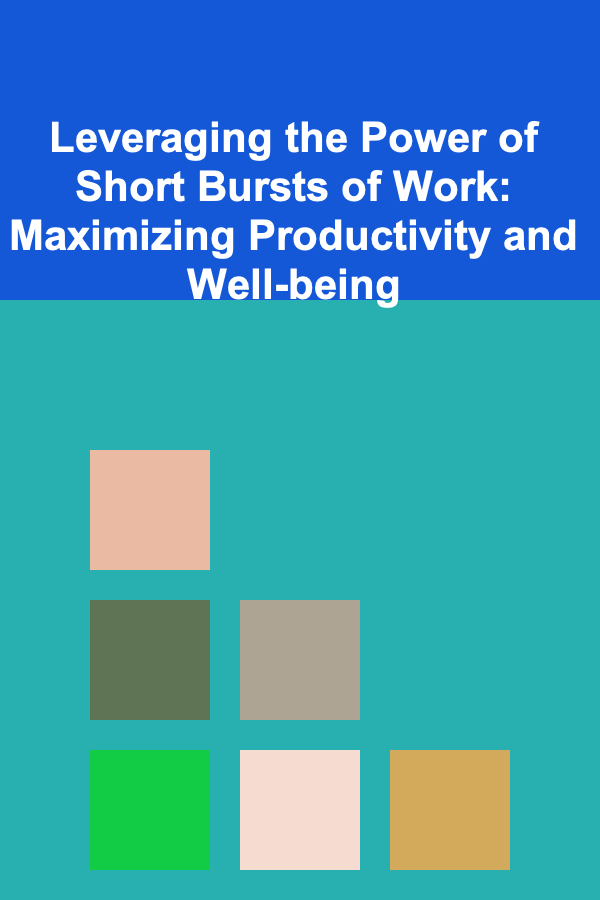
Leveraging the Power of Short Bursts of Work: Maximizing Productivity and Well-being
ebook include PDF & Audio bundle (Micro Guide)
$12.99$5.99
Limited Time Offer! Order within the next:

In today's fast-paced and demanding world, the ability to focus and maintain productivity is a critical skill for success. However, prolonged periods of concentrated work can lead to mental fatigue, reduced performance, and even burnout. The concept of working in short bursts, often referred to as timeboxing, the Pomodoro Technique, or focused sprints, offers a powerful alternative, allowing individuals to maximize their cognitive resources while mitigating the negative effects of overwork. This article delves deep into the science and practical applications of short bursts of work, exploring its benefits, different methodologies, implementation strategies, and potential challenges. We will examine how this approach can be tailored to various tasks and individual preferences, ultimately leading to increased productivity, improved focus, and enhanced well-being.
The Science Behind Short Bursts: Cognitive Load and Attention Span
The effectiveness of short bursts of work is rooted in fundamental principles of cognitive psychology. Our brains have a limited capacity for processing information and sustaining attention, often referred to as cognitive load. When we attempt to focus intensely for extended periods, this cognitive load increases, leading to a depletion of mental resources. This depletion manifests as decreased alertness, impaired decision-making, and a general decline in performance. The human attention span is also not as long as we often assume. Studies suggest that sustained attention typically begins to wane after approximately 20-25 minutes, after which our minds naturally tend to wander.
Working in short, focused intervals addresses these limitations by:
- Reducing Cognitive Overload: By breaking down work into manageable segments, we minimize the sustained cognitive demand, allowing our brains to recover and replenish resources during the breaks.
- Capitalizing on Peak Focus: Short bursts align with the natural fluctuations in our attention span, allowing us to leverage periods of heightened focus and concentration.
- Promoting Active Recall and Learning: The act of pausing and reflecting after each burst facilitates memory consolidation and deeper understanding of the material covered.
- Maintaining Motivation and Engagement: The frequent completion of tasks within a defined timeframe provides a sense of accomplishment, boosting motivation and reducing procrastination.
Essentially, short bursts of work enable us to work smarter, not harder, optimizing our cognitive resources and maximizing our output.
Popular Methodologies: The Pomodoro Technique and Beyond
Several methodologies have been developed to structure work around short bursts, each with its own nuances and variations. The most well-known is undoubtedly the Pomodoro Technique, but it's important to recognize that it's just one approach among many.
The Pomodoro Technique
Developed by Francesco Cirillo in the late 1980s, the Pomodoro Technique is a time management method that uses a timer to break down work into intervals, traditionally 25 minutes in length, separated by short breaks. The name "Pomodoro" comes from the tomato-shaped kitchen timer that Cirillo used as a student.
The core steps of the Pomodoro Technique are:
- Choose a task to be accomplished. Select a specific, well-defined task that you want to focus on.
- Set a timer for 25 minutes. The timer serves as a commitment device, helping you stay focused during the interval.
- Work on the task until the timer rings. Dedicate your full attention to the task, minimizing distractions.
- Take a short break (5 minutes). Use this time to relax, stretch, or disengage from the task mentally.
- Every four "pomodoros," take a longer break (20-30 minutes). This longer break allows for more significant mental recovery.
- Repeat steps 1-5 until the task is complete.
The Pomodoro Technique is simple yet effective, providing a structured framework for focused work. Its key benefits include:
- Improved Focus and Concentration: The timed intervals encourage intense focus and discourage procrastination.
- Reduced Distractions: The clear boundaries of the Pomodoro interval help to minimize interruptions.
- Enhanced Time Awareness: Tracking the number of pomodoros completed provides a better understanding of how long tasks actually take.
- Increased Motivation: The sense of accomplishment after each pomodoro can boost motivation and reduce feelings of overwhelm.
Other Timeboxing Approaches
While the Pomodoro Technique is widely used, it's important to recognize that the specific duration of the work intervals and breaks can be adjusted to suit individual preferences and task requirements. Other timeboxing approaches include:
- 50/10 Rule: Work for 50 minutes, followed by a 10-minute break. This longer interval might be suitable for tasks that require deep concentration and less frequent interruptions.
- 90-Minute Blocks: Inspired by the ultradian rhythms of sleep, some individuals find that 90-minute blocks of focused work followed by 20-30 minute breaks align better with their natural energy cycles. This approach is often used for highly demanding cognitive tasks.
- Customized Intervals: The most flexible approach involves experimenting with different interval durations to identify the optimal balance between focus and rest for specific tasks. This requires careful self-monitoring and adjustment based on personal experience.
The key is to find a rhythm that works best for you, considering your individual attention span, task complexity, and energy levels.
Implementing Short Bursts: Practical Strategies and Tips
Successfully implementing short bursts of work requires more than just setting a timer. It involves creating an environment conducive to focus, minimizing distractions, and developing effective work habits. Here are some practical strategies and tips:
Setting Clear Goals and Priorities
Before starting any work session, it's crucial to define clear goals and priorities. What specific tasks do you want to accomplish during this interval? What are the most important items on your to-do list? Having a clear understanding of your objectives will help you stay focused and avoid getting sidetracked.
- Break down large tasks: Divide complex projects into smaller, more manageable subtasks. This makes the overall project feel less daunting and allows you to make tangible progress during each short burst.
- Prioritize ruthlessly: Focus on the tasks that will have the greatest impact. Use techniques like the Eisenhower Matrix (urgent/important) to prioritize your work effectively.
- Write down your goals: Clearly writing down your goals for each work session reinforces your commitment and helps you stay on track.
Creating a Distraction-Free Environment
Minimizing distractions is essential for maximizing focus during short bursts of work. This includes both internal and external distractions.
- Eliminate external distractions: Turn off notifications on your phone and computer, close unnecessary browser tabs, and find a quiet workspace where you won't be interrupted.
- Manage internal distractions: Address any pressing thoughts or anxieties before starting your work session. Use techniques like mindfulness meditation or journaling to clear your mind.
- Communicate your boundaries: Let others know when you need uninterrupted time to focus. Set clear expectations about when you are available and when you are not.
- Use website blockers: Install browser extensions or apps that block distracting websites during your work sessions.
Choosing the Right Tools and Technology
Several tools and technologies can help you implement short bursts of work effectively. These include:
- Timers: Use a physical kitchen timer, a smartphone app, or a dedicated Pomodoro timer to track your work intervals and breaks. There are numerous Pomodoro timer apps available for both iOS and Android.
- Task management apps: Use task management apps like Todoist, Asana, or Trello to organize your tasks, set deadlines, and track your progress.
- Focus apps: Explore focus apps like Freedom or Forest, which block distracting websites and apps during your work sessions.
- Note-taking apps: Use note-taking apps like Evernote or OneNote to capture ideas, record progress, and reflect on your work sessions.
The Importance of Breaks: Rest and Rejuvenation
The breaks between work intervals are just as important as the work itself. These breaks provide an opportunity for your brain to rest, recharge, and consolidate information.
- Step away from your workspace: Get up and move around, stretch, or take a short walk.
- Engage in relaxing activities: Listen to music, read a book, or practice mindfulness meditation.
- Avoid screen time during breaks: Staring at screens during breaks can actually increase mental fatigue. Instead, engage in activities that don't involve electronic devices.
- Hydrate and nourish yourself: Drink water and eat healthy snacks to maintain your energy levels.
Experiment with different break activities to find what works best for you. The goal is to completely disengage from your work and allow your mind to wander freely.
Adapting to Different Tasks and Work Styles
The optimal length of work intervals and breaks can vary depending on the type of task you're working on and your individual work style. Experiment with different durations to find what works best for you.
- For creative tasks: Shorter intervals (e.g., 25 minutes) may be more effective for brainstorming and generating ideas.
- For analytical tasks: Longer intervals (e.g., 50 minutes) may be more suitable for deep concentration and problem-solving.
- For tasks you enjoy: You may be able to work for longer stretches before needing a break.
- For tasks you dislike: Shorter intervals may make the task feel less overwhelming and increase your motivation to start.
Be flexible and willing to adjust your approach as needed. The key is to find a rhythm that allows you to maintain focus, productivity, and well-being.
Dealing with Interruptions and Setbacks
Despite your best efforts, interruptions and setbacks are inevitable. It's important to have a plan for dealing with them.
- Acknowledge the interruption: Instead of getting frustrated, acknowledge the interruption and address it briefly.
- Reschedule the interruption: If the interruption can wait, politely reschedule it for a later time.
- Restart your timer: If you're interrupted during a work interval, simply restart your timer and continue working.
- Don't beat yourself up: Everyone gets interrupted from time to time. Don't let setbacks derail your progress.
Benefits Beyond Productivity: Well-being and Work-Life Balance
While increased productivity is a primary benefit of using short bursts of work, the positive effects extend far beyond mere output. This approach can significantly enhance well-being and contribute to a healthier work-life balance.
- Reduced Stress and Burnout: By preventing prolonged periods of intense focus, short bursts help to avoid cognitive overload and mental exhaustion. This, in turn, reduces stress levels and the risk of burnout. Regular breaks provide opportunities for relaxation and rejuvenation, allowing you to return to your work feeling refreshed and energized.
- Improved Focus and Concentration: The structured nature of short bursts training the mind to focus more effectively. By consistently practicing focused attention for defined periods, you can improve your overall concentration skills. This can have a positive impact on various aspects of your life, not just your work.
- Enhanced Time Management Skills: Using short bursts necessitates planning and prioritization. As you become more aware of how you spend your time, you'll develop better time management skills. This allows you to allocate your time more effectively and achieve your goals more efficiently.
- Increased Motivation and Engagement: The frequent sense of accomplishment from completing tasks within each interval can boost motivation and engagement. Breaking down large tasks into smaller, more manageable segments makes them feel less overwhelming and increases your likelihood of starting and completing them.
- Better Work-Life Balance: By setting clear boundaries between work and rest, short bursts can help you to achieve a better work-life balance. The structured breaks encourage you to step away from your work and engage in other activities, preventing you from becoming completely consumed by your job.
Potential Challenges and How to Overcome Them
While the benefits of short bursts are numerous, there are also potential challenges that individuals may encounter when implementing this approach.
- Difficulty Focusing Initially: It may take time to train your mind to focus intensely for short periods, especially if you are accustomed to multitasking or working in a distracted environment. Solution: Start with shorter intervals and gradually increase the duration as your focus improves. Use techniques like mindfulness meditation to train your attention.
- Resistance to Taking Breaks: Some individuals may feel guilty or unproductive when taking breaks, even though they are essential for maintaining focus and preventing burnout. Solution: Recognize that breaks are an integral part of the process and are essential for long-term productivity and well-being. Schedule your breaks and treat them as important appointments.
- Interruptions and Distractions: Unexpected interruptions can disrupt your work intervals and make it difficult to maintain focus. Solution: Minimize distractions by creating a dedicated workspace, turning off notifications, and communicating your boundaries to others. Develop a plan for dealing with interruptions effectively.
- Procrastination: Even with structured intervals, procrastination can still be a challenge. Solution: Break down tasks into even smaller, more manageable steps. Use techniques like the "5-minute rule" to overcome inertia and get started. Focus on the benefits of completing the task rather than the perceived difficulty.
- Finding the Right Rhythm: Determining the optimal length of work intervals and breaks can require experimentation. Solution: Track your productivity and energy levels over time to identify patterns. Adjust your intervals and breaks based on your personal experience and feedback.
Conclusion: Embrace the Power of Focused Sprints
Leveraging the power of short bursts of work is a highly effective strategy for maximizing productivity, improving focus, and enhancing well-being. By understanding the science behind this approach, implementing practical strategies, and adapting to individual preferences, individuals can unlock their full potential and achieve their goals more efficiently and effectively. Embrace the power of focused sprints and experience the transformative impact it can have on your work and your life.

How to Build DIY Storage Solutions for Every Room in Your Home
Read More
How to Create a Dedicated Space for Luxury Home Décor
Read More
How to Make a Checklist for Creating Compelling Video Content
Read More
How to Start Beekeeping at Home with Minimal Investment
Read More
How to Use a Survey to Determine Family Interests
Read More
How to Use Checklists for Daily Camp Operations
Read MoreOther Products

How to Build DIY Storage Solutions for Every Room in Your Home
Read More
How to Create a Dedicated Space for Luxury Home Décor
Read More
How to Make a Checklist for Creating Compelling Video Content
Read More
How to Start Beekeeping at Home with Minimal Investment
Read More
How to Use a Survey to Determine Family Interests
Read More